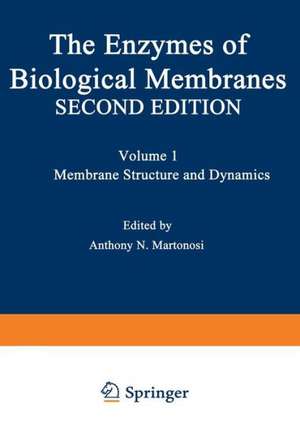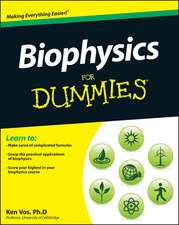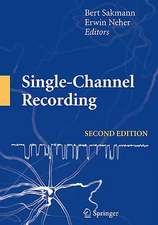The Enzymes of Biological Membranes: Volume 1 Membrane Structure and Dynamics
Editat de A.N. Martonosien Limba Engleză Paperback – 15 iul 2012
Preț: 654.77 lei
Preț vechi: 770.31 lei
-15% Nou
Puncte Express: 982
Preț estimativ în valută:
125.29€ • 133.98$ • 104.46£
125.29€ • 133.98$ • 104.46£
Carte tipărită la comandă
Livrare economică 18 aprilie-02 mai
Preluare comenzi: 021 569.72.76
Specificații
ISBN-13: 9781468446005
ISBN-10: 1468446002
Pagini: 476
Ilustrații: XXII, 474 p. 127 illus.
Dimensiuni: 178 x 254 x 25 mm
Greutate: 0.82 kg
Ediția:Softcover reprint of the original 1st ed. 1985
Editura: Springer Us
Colecția Springer
Locul publicării:New York, NY, United States
ISBN-10: 1468446002
Pagini: 476
Ilustrații: XXII, 474 p. 127 illus.
Dimensiuni: 178 x 254 x 25 mm
Greutate: 0.82 kg
Ediția:Softcover reprint of the original 1st ed. 1985
Editura: Springer Us
Colecția Springer
Locul publicării:New York, NY, United States
Public țintă
ResearchCuprins
of Volume 1.- 1. Electron Microscopy of Biological Membranes.- I. Introduction.- II. Methods Used for Studying Biological Membranes in the Electron Microscope.- References.- 2. Associations of Cytoskeletal Proteins with Plasma Membranes.- I. Introduction.- II. The Components of the Cytoskeleton.- III. Cytoskeletal Functions.- IV. The Erythrocyte Membrane Skeleton: A Completely Membrane Associated Cytoskeleton.- V. Cytoskeletal Involvement in Cell—Substratum Associations.- VI. Cytoskeletal—Membrane Interactions in Microvilli of the Intestinal Brush Border.- VII. Membrane-Associated Cytoskeletal Elements and the Control of Cell Surface Receptor Dynamics.- VIII. Summary.- References.- 3. Cell Coupling.- I. Introduction.- II. Which Molecules Diffuse from Cell to Cell.- III. How Molecules Diffuse for Cell-to-Cell.- IV. How Cell-to-Cell Diffusion of Molecules is Regulated.- References.- 4. Lipid Polymorphism and Membrane function.- I. Introduction.- II. Membrane Lipid Polymorphism: Technical Aspects.- III. Phase Preferences of Membrane Lipids.- IV. The Hexagonal HII Phase.- V. Modulation of Membrane Lipid Polymorphism.- VI. “Isotropic” Lipid Structures and Lipid Particles.- VII. The Shape Concept, a Rationale for Lipid Polymorphism.- VIII. Functional Aspects of Lipid Polymorphism.- IX. Lipid Structure in Biological Membranes.- X. Concluding Remarks.- References.- 5. Intrinsic Protein-Lipid Interactions in Biomembranes.- I. Introduction.- II. Properties of Biomembrane Components.- III. Lipid Composition and Enzyme Activity.- IV. Specificity of Protein-Lipid Interactions.- V. Distribution of Proteins in Membranes.- VI. Perturbation of Lipid Dynamics by Intrinisic Proteins.- VII. The Effect of Protein on Lipid Conformation.- VIII. The Influence of Lipids on ProteinConformation.- IX. Diffusion of Membrane Components.- X. Summary.- References.- 6. On the Molecular Structure of the Gramicidin Transmembrane Channel.- I. Introduction.- II. Planar Lipid Bilayer Transport Studies.- III. Spectroscopic Characterization of the Lipid Incorporated Channel State.- References.- 7. Conventional ESR Spectroscopy of Membrane Proteins: Recent Applications.- I. Introduction.- II. The Time Scale of Phospholipid Exchange at the Boundary of Non Aggregated Intrinsic Proteins.- III. Lipids Trapped between Protein Aggregates or Protein Oligomers.- IV. Specificity of Lipid—Protein Interactions as Investigated with Spin Labels.- V. Interactions between Extrinsic Proteins and Lipids.- VI. Other Applications of Conventional ESR Spectroscopy to the Investigation of Membrane-Bound Enzymes.- References.- 8. Saturation Transfer EPR Studies of Microsecond Rotational Motions in Biological Membranes.- I. Introduction.- II. ST-EPR Methodology.- III. Membrane-Bound Enzymes.- IV. Other Membrane Proteins.- V. Lipid Probes.- VI. Summary.- References.- 9. Dye Probes of Cell, Organelle, and Vesicle Membrane Potentials.- I. Introduction.- II. Types of Potential Sensitive Dyes.- III. Slow Dyes.- IV. Fast Dyes.- References.- 10. Selective Covalent Modification of Membrane Components.- I. Introduction.- II. Covalent Modification of Lipid Components.- III. Selective Covalent Modification of Protein Components.- IV. Information Acquired through Selective Modification.- References.- 11. Calcium Ions, Enzymes, and Cell Fusion.- I. Introduction.- II. The Fusion of Myoblasts.- III. General Hypotheses: Ca2+, Phospholipids and Membrane Fusion.- IV. Cell Fusion and Vesicle Fusion without Ca2+.- V. Concluding Comments.- References.- 12. Role of Membrane Fluidity in the Expression ofBiological Functions.- I. Introduction.- II. Meaning and Measurement of Membrane Fluidity.- III. Factors that Influence Membrane Fluidity.- IV. Mechanisms by which Membrane Fluidity Influences Membrane Functions.- V. Role of Membrane Fluidity in Some Membrane Functions.- References.- 13. Rotational Diffusion of Membrane Proteins: Optical Methods.- I. Historical Background.- II. Physical Model for Rotational Diffusion of a Membrane Protein.- III. Physical Principles of Photoselection.- IV. Intrinsic and Extrinsic Probes.- V. Time-Resolved and Steady-State Methods.- VI. Linear Dichroism.- VII. Delayed Fluorescence.- VIII. Phosphorescence.- IX. Fluorescence Depletion.- X. Applications.- XI. Prospects.- References.









